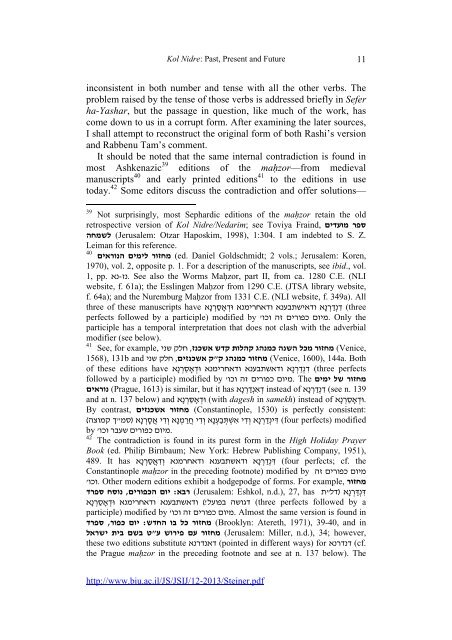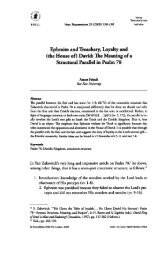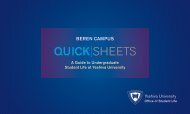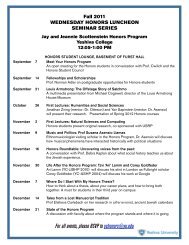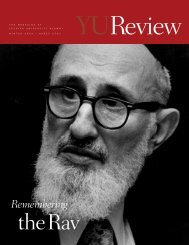Richard Steiner, Kol Nidre - Yeshiva University Blogs
Richard Steiner, Kol Nidre - Yeshiva University Blogs
Richard Steiner, Kol Nidre - Yeshiva University Blogs
Create successful ePaper yourself
Turn your PDF publications into a flip-book with our unique Google optimized e-Paper software.
<strong>Kol</strong> <strong>Nidre</strong>: Past, Present and Future11inconsistent in both number and tense with all the other verbs. Theproblem raised by the tense of those verbs is addressed briefly in Seferha-Yashar, but the passage in question, like much of the work, hascome down to us in a corrupt form. After examining the later sources,I shall attempt to reconstruct the original form of both Rashi’s versionand Rabbenu Tam’s comment.It should be noted that the same internal contradiction is found inmost Ashkenazic 39 editions of the maḥzor—from medievalmanuscripts 40 and early printed editions 41 to the editions in usetoday. 42 Some editors discuss the contradiction and offer solutions—39Not surprisingly, most Sephardic editions of the maḥzor retain the oldספר מועדים Fraind, retrospective version of <strong>Kol</strong> <strong>Nidre</strong>/Nedarim; see ToviyaZ. (Jerusalem: Otzar Haposkim, 1998), 1:304. I am indebted to S. לשמחהLeiman for this reference.40Koren, (ed. Daniel Goldschmidt; 2 vols.; Jerusalem: מחזור לימים הנוראים1970), vol. 2, opposite p. 1. For a description of the manuscripts, see ibid., vol.1, pp. .נז-נא See also the Worms Maḥzor, part II, from ca. 1280 C.E. (NLIwebsite, f. 61a); the Esslingen Maḥzor from 1290 C.E. (JTSA library website,f. 64a); and the Nuremburg Maḥzor from 1331 C.E. (NLI website, f. 349a). Allthree of these manuscripts have דִ נְדַ רְ נָא ודאישתבענא ודאחרימנא וּדְ אָסַ רְ נָא (threeperfects followed by a participle) modified by ' כפורים זה וכו .מיום Only theparticiple has a temporal interpretation that does not clash with the adverbialmodifier (see below).41See, for example, ,1568), 131b and מחזור כמנהג ק לק שני (Venice, 1600), 144a. Both(Venice, מחזור מכל השנה כמנהג קהלות קדש אשכנז חלק שני"ק אשכנזים, חof these editions have דִ נְ דַ רְ נָא ודאשתבענא ודאחרימנא וּדְ אָסַ רְ נָא (three perfectsמחזור של ימים . Theמיום כפורים זה וכו ' by followed by a participle) modifiedn. 139 (see דִ נְדַ רְ נָא instead of דְ אִ נְדַ רְ נָא (Prague, 1613) is similar, but it has נוראים.וּדְ אָסַ רְ נָא (with dagesh in samekh) instead of וּדְ אָ סַּ רְ נָא and at n. 137 below) andBy contrast, מחזור אשכנזים (Constantinople, 1530) is perfectly consistent:( (four perfects) modified' .42The contradiction is found in its purest form in the High Holiday PrayerBook (ed. Philip Birnbaum; New York: Hebrew Publishing Company, 1951),(four perfects; cf. theמיום כפורים זה Constantinople maḥzor in the preceding footnote) modified byמחזור example, . Other modern editions exhibit a hodgepodge of forms. For 'דִּ (Jerusalem: Eshkol, n.d.), 27, has נוסח ספרדדִּ ינְדַ רְ נָא וְ דִ י אִ שְׁ תְּ בַ עְ נָא וְ דִ י חֲ רַ מְ נָא וְ דִ י אֲ סָ רְ נָא (סמ"ך קמוצהמיום כפורים שעבר וכו byדִּ נְדַ רְ נָא ודאשתבענא ודאחרמנא וְ דִ אֲ סַ רְ נָא .489 It hasוכורבא: יום הכפורים,נְדַּ רְ נָא (דל"ת(three perfects followed by a דגושה בפועל!) ודאשתבענא ודאחרימנא וּדְ אָסַ רְ נָאמיום כפורים זה וכו participle) modified byמחזור כל בו החדש: יום כפור,מחזור עם פירוש ע"'. Almost the same version is found in(Brooklyn: Atereth, 1971), 39-40, and in ספרדhowever, (Jerusalem: Miller, n.d.), 34; ט בשם בית ישראלthese two editions substitute דאנדרנא (pointed in different ways) for דנדרנא (cf.the Prague maḥzor in the preceding footnote and see at n. 137 below). Thehttp://www.biu.ac.il/JS/JSIJ/12-2013/<strong>Steiner</strong>.pdf


